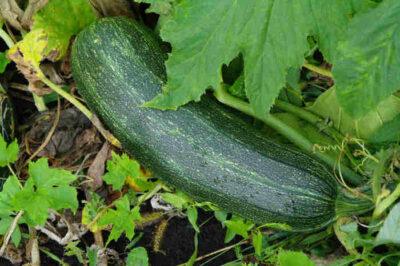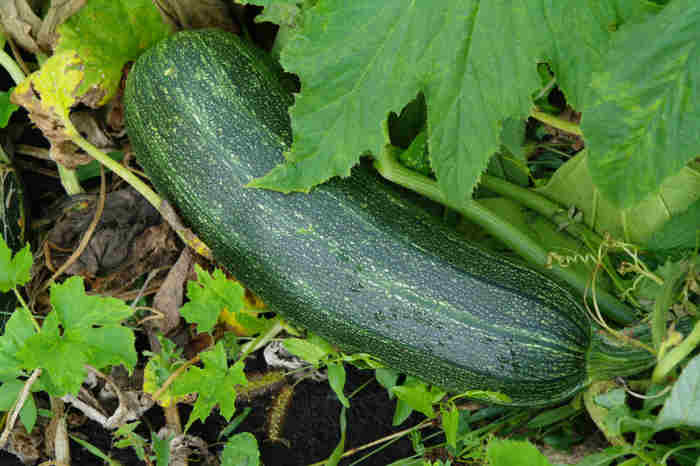
Zucchini is easy to plant, easy to grow and delicious to eat, making it a favorite to grow in a garden. A summer squash, it comes in all sizes and shapes. It can grow up to several feet in length if left on the vine long enough. In fact, a Canadian man holds the Guinness World Record for longest zucchini ever grown. It was 7 feet, 10 inches in length!
Zucchini is usually some shade of light or dark green, but there are beautiful yellow, orange and gold varieties (this is not to mention all the varieties with stripes). Although treated like a vegetable, zucchini is actually a fruit. It came from the Americas and eventually made its way to Italy.
Common Varieties of Zucchini
- Aristocrat – grows to a medium green shade and has waxy or glossy skin. Its fruit is straight and only takes 53 days to mature to harvest.
- Black Zucchini – Here is one of the most common types of zucchini. It has dark green skin and has white flesh. This variety is a larger type with high yields, and is great for freezing. It only takes 48 days to mature.
- Zucchini Gadzukes – This is a compact variety. It is a dark green fruit with light green edges. It looks like a star when you cut it crosswise. It has a texture that is crisp and a sweet taste. Gadzukes take 55 days to mature.
- Gold Rush – Here is the unique, compact variety of zucchini. It is a gold color and has the usual zucchini flavor. It is a smaller variety of zucchini, making it perfect for small gardens and areas. Fifty-two days is all it takes until it is ready to be picked.
- Greyzini – This zucchini only takes 47 days to mature. It has sweet, tender fruit and a skin that is green with lighter green stripes.
- Sweet Gourmet – Its skin is described as a creamy, green color. Sweet Gourmet is a Lebanese zucchini with a tapered, compact fruit. This variety can produce high yields. It will take 50 days to mature, but it’s worth the wait due to its mild flavor with a touch of sweetness.
- Black Beauty – This compact variety has very dark, green skin. It takes 48 days to grow.
- Embassy – Embassy is another heavy producer whose plants seem almost spineless. Its fruit is a medium green color.
How to Plant Zucchini
You can grow zucchini alone as a single plant or in groups on mounds or small hills. Zucchini does very well in full sunlight (at least six to 10 hours) and needs room to spread. Well-draining soil is ideal to use or plant in.
The Best Source For Non-GMO Heirloom Seeds Is Right Here!
Always plant after the threat of frost is gone. Make holes about one-half inch to one-inch deep and place one seed or seedling per hole. When planting on mounds, make hills of soil from six to 12 inches high, and no wider than 12 to 24 inches. Four to five seeds should be put in each hill and thinned back to two or three once the seedlings have leaves.
You also can start zucchini in your house to give seedlings a head start on the spring growing season. Try planting the seeds four to six weeks before the frost ends, then plant outside when the weather is right.
Caring for Zucchini Plants
 Seedlings can have mulch placed around them to keep the temperature of the ground constant. This also helps to retain water. By doing this, your zucchini will be ready to harvest earlier and have a large yield.
Seedlings can have mulch placed around them to keep the temperature of the ground constant. This also helps to retain water. By doing this, your zucchini will be ready to harvest earlier and have a large yield.
Water your plants at least twice a week as they need a couple inches of water per week. If watering by hand, water below the leaves. If the plants are sprayed on top by a hose they can develop mildew.
New Natural Fertilizer Doubles Garden Production!
Try not to let the zucchini get too big. They are more tasty and soft when they are smaller.
Zucchini Pests and Problems
Although zucchini is easy to grow, you might have to battle the occasional pest. Here’s the usual suspects and how to handle them:
- Cucumber Beetles – These pests can have black stripes or spots on their orange or green back. They eat the leaves of plants and their larva eat the roots. This type of beetle also can carry “cucumber bacterial wilt.” You can introduce natural predators like solider beetles or ground beetles to eradicate them.
- Aphids – Aphids cause leaves to become yellow and distorted. They tend to leave a sticky, black substance after they eat. You can use natural predators such as lacewings and ladybugs (which seem to be a predator to many of these pests,) as well as dandelions, fennel, mint and yarrow. You also can trim the lower part of the plant to help deter these pests.
- Cutworms – A type of caterpillar who chews through plant stems right at ground level. To prevent these little guys from invading, keep your garden clean – their eggs usually hatch in weeds or dead plants. If you notice cutworms in your garden but don’t want to use pesticides, try a wash with bleach-free dish soap.
- Whiteflies – They look like white moths and are part of a sap-sucking group of pests. You can use natural pesticides or introduce natural predators.
- Squash Bugs – This brown, winged pest has a very distinctive look. You can create a trap for them by putting cardboard and newspaper in the garden. The bugs will go beneath the paper at night and you can collect the bugs in the morning. You can then put them in a bucket of soapy water to kill them.
To avoid diseases, make sure your zucchini get plenty of sun, water and have good air flow around the plants.
Harvesting
Once zucchini start maturing, you should check the plants every day for fruit that is ready to pick. Always check under the leaves, as zucchini can sometimes be hidden. The fruit should be firm and not mushy.
Once the fruit is between six and 12 inches in length, you can pick zucchini regularly. Doing this encourages more zucchini to grow. To speed up growth, pick more fruit. To slow the harvest season, pick less (leave one or two fruits on the vine at a time).
There are a couple of ways of removing the fruit from the stem. You can use a sharp knife and cut the stem (which can be rough) that attaches the fruit. You also can simply hold the zucchini and slowly (very slowly) twist. The fruit will usually come off after turns of 90 to 180 degrees.
Once you have grown and harvested your zucchini, the next step in your adventure begins! Enjoy your zucchini in salads, breads, soups and more.
What are your zucchini growing tips? Share them in the section below:
Don’t Ever Plant Anything But Heirloom Seeds. Read More Here.









